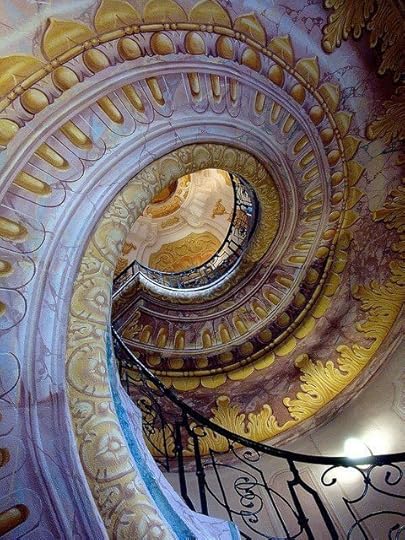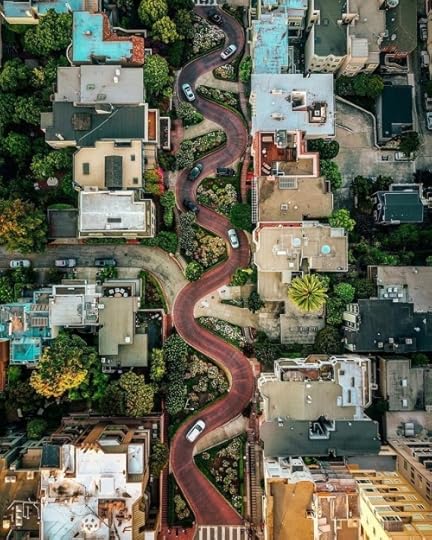Chris Howard's Blog, page 61
July 5, 2018
Memorial Bridge in Portsmouth New Hampshire, many July 4ths ago.
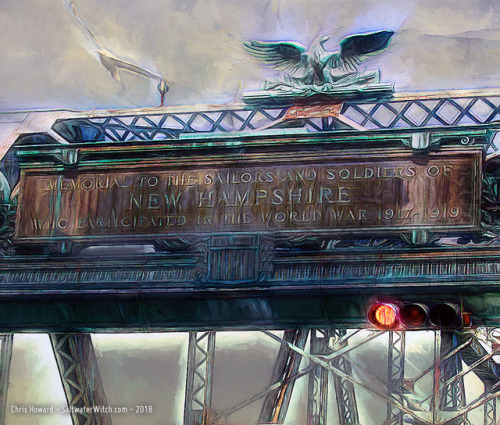
Memorial Bridge in Portsmouth New Hampshire, many July 4ths ago.
July 4, 2018
I was out with the AstroTech f/9 1350mm scope last...
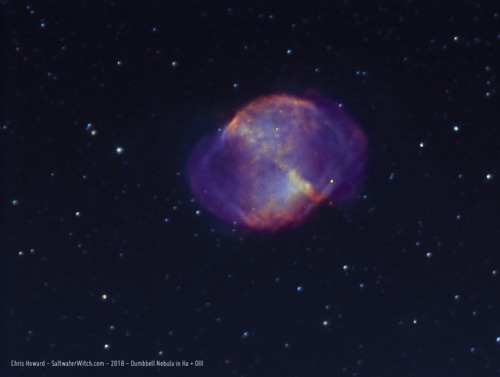

I was out with the AstroTech f/9 1350mm scope last night–not the clearest night, but clear enough. The Dumbbell Nebula (NGC 6853), also called the Apple Core Nebula, is a planetary nebula in the constellation Vulpecula. I setup the AstroTech with 1350mm focal length, paired with the Atik 414EX mono CCD. This gives me .98" / pixel resolution and oversampling, but still managed to get some detail out of the nebula. (Imaging info: 63 x 90 second subs in OIII, 96 x 60 sec. subs of Ha. + 20 dark frames stacked in Nebulosity, processing in PSCC2018. Equipment: AstroTech AT6RC f/9 Ritchey-Chrétien, Atik 414EX mono CCD, 7nm Optolong 2" Ha filter, 8.5nm Baader 2" OIII filter, Orion Atlas EQ-G Mount, ZWO ASI120MM-S Guide Cam + WO 50/200mm guide scope)
July 1, 2018
I was out last night with the William Optics ZS61 and Atik...
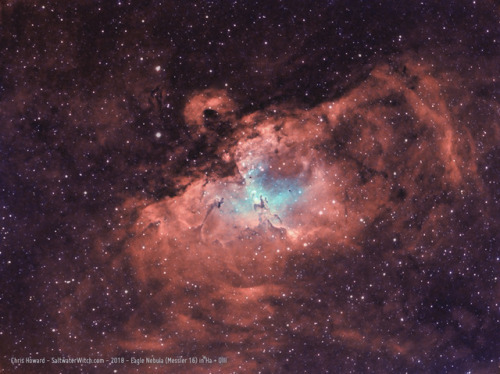
I was out last night with the William Optics ZS61 and Atik 414EX, doing some narrowband imaging. The Eagle Nebula (Messier 16, NGC 6611, Star Queen Nebula) is an open star cluster and emission nebula in the constellation Serpens, about 7000 lightyears away from us. Imaging Info: 96 x 240 sec. Ha + 41 x 240 sec. OIII frames stacked in DSS, processed in PSCC2018. These frame numbers are a bit unbalanced, but the clouds moved in during the OIII sequence, and there was nothing I could do. I went ahead and stacked and processed them as they are. I’ll probably come back to this one in the future with more oxygen-3 (and maybe sulphur-2) to achieve something like the actual proportional levels of light from the nebula across these bandpasses. Equipment: William Optics ZS61, Atik 414EX mono CCD, 12nm Astronomik Ha filter, 12nm Astronomik OIII filter, CEM25P EQ Mount, ZWO ASI120MM-S Guide Cam + Orion TOAG, INDI/KStars/Ekos control software. Location: Stratham, New Hampshire, Bortle: 4, SQM: 20.62
June 27, 2018
angelocerantola:Ocean Kisses © Angelo Cerantola
June 26, 2018
The Swan Nebula (M17) bi-color narrowband with the William...
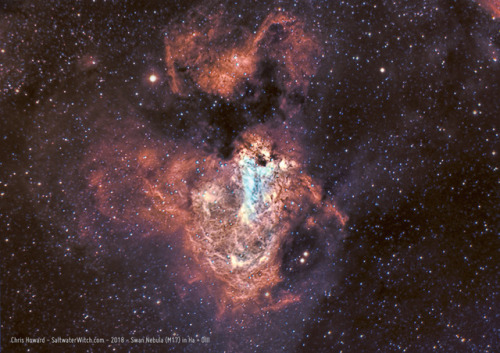
The Swan Nebula (M17) bi-color narrowband with the William Optics ZS61 and the Atik 414EX monochrome CCD. Messier 17 is also called the Omega Nebula, Checkmark Nebula, and sometimes the Horseshoe Nebula, but all I see is a swan–with a black beak, neck arched forward, and wings outstretched. The bright region in the middle is the swan’s chest. I shot the hydrogen-alpha frames on June 16th (16 x 300 second exposures + 82 x 120 second exposures) and I came back on the 21st to shoot 40 x 300 second exposures in oxygen-3. I decided not to shoot sulphur-2 frames based on the wonderful result with bi-color for my Cygnus Wall image set (6.8 hours of Ha + OIII). For the Swan Nebula (this post) and Cygnus Wall (last post) images I used the Hydrogen-alpha/Oxygen-3 bi-color process developed in an article by Travis Rector, et. al. in The Astronomical Journal here: https://doi.org/10.1086/510117, and detailed here: http://www.starrywonders.com/bicolortechniquenew.html
June 25, 2018
Special FREE READ 10th anniversary promotion through...

Special FREE READ 10th anniversary promotion through July.
http://www.saltwaterwitch.com/seaborncrown
Read both books for free–online or in your favorite ebook reader. Please share!
June 23, 2018
The view from my backyard, with the right equipment focused on a...

The view from my backyard, with the right equipment focused on a particular part of the sky: Cygnus Wall region of NGC 7000, the North America nebula, imaged in narrowband Ha and OIII. The way narrowband imaging works is by filtering out all light except for an allowed narrow bandpass at specific locations in the electromagnetic spectrum. A hydrogen-alpha (Ha) filter will only allow light to pass through to the camera sensor around 656 nanometers, which is out at the red end of the spectrum, and an oxygen-3 (OIII) filter will only allow light to pass through around 501nm, which is in the middle of the blue and green ranges. When I say red, green, blue, I’m talking about where these bandpass lines fall within the scope of the visible spectrum, which starts around 390 and goes to 700 or so (for humans). I shot the oxygen-3 sub-exposures last week, and the hydrogen-alpha subs last night. When you process these separately filtered images into one color image, you may get the Ha coming out vivid red to rust red, and the OIII coming out in blues and greens. The Cygnus Wall is that bright, rolling line across the middle where you have a lot of concentrated star formation, but this area of NGC 7000 also has lot of dust and debris drifting in front of it–the dark reddish-brown regions across the top and right side. (Imaging info: 42 x 300 second subs in OIII, 40 x 300 sec. subs of Ha. + 20 dark frames stacked in DSS, processing in PSCC2018 + Astronomy Tools actions & Annie’s Astro actions. Equipment: William Optics ZS61, Atik 414EX mono CCD, 7nm Optolong 2" Ha filter, 8.5nm Baader 2" OIII filter, CEM25P EQ Mount, ZWO ASI120MM-S Guide Cam, http://SaltwaterWitch.com/astronomy).
June 17, 2018
It was narrowband time last night in the backyard. I took a...
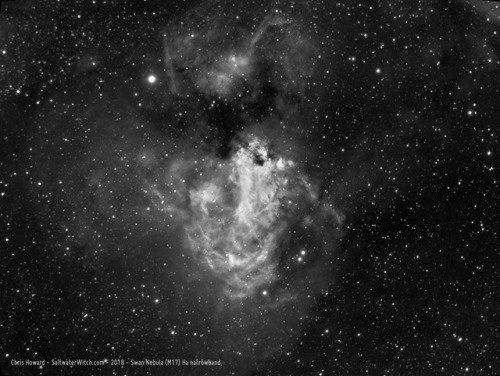
It was narrowband time last night in the backyard. I took a couple hours of hydrogen-alpha (Ha) sub-exposures of M17, the Swan Nebula in the constellation Sagittarius. M17 is about 5,500 light-years away. It’s also called the Omega Nebula, Checkmark Nebula, and sometimes the Horseshoe Nebula. I started to take a few OIII frames, but by that time M17 was heading back toward the southern horizon, and so I jumped over to the “Cygnus Wall” in NGC 7000 (North America Nebula). I captured several hours of OIII data there, amazing stuff, but you’ll have to wait for me to follow up with another round for Ha and possible SII to see the finished image. (M17 info: 16 x 300 second + 82 x 120 second exposures + 20 dark frames stacked in DSS, William Optics ZS61, Atik 414EX mono CCD, 7nm Optolong 2" Ha filter, CEM25P EQ Mount, QHY5III178 guide cam with the Orion TOAG, https://www.astrobin.com/351595).


